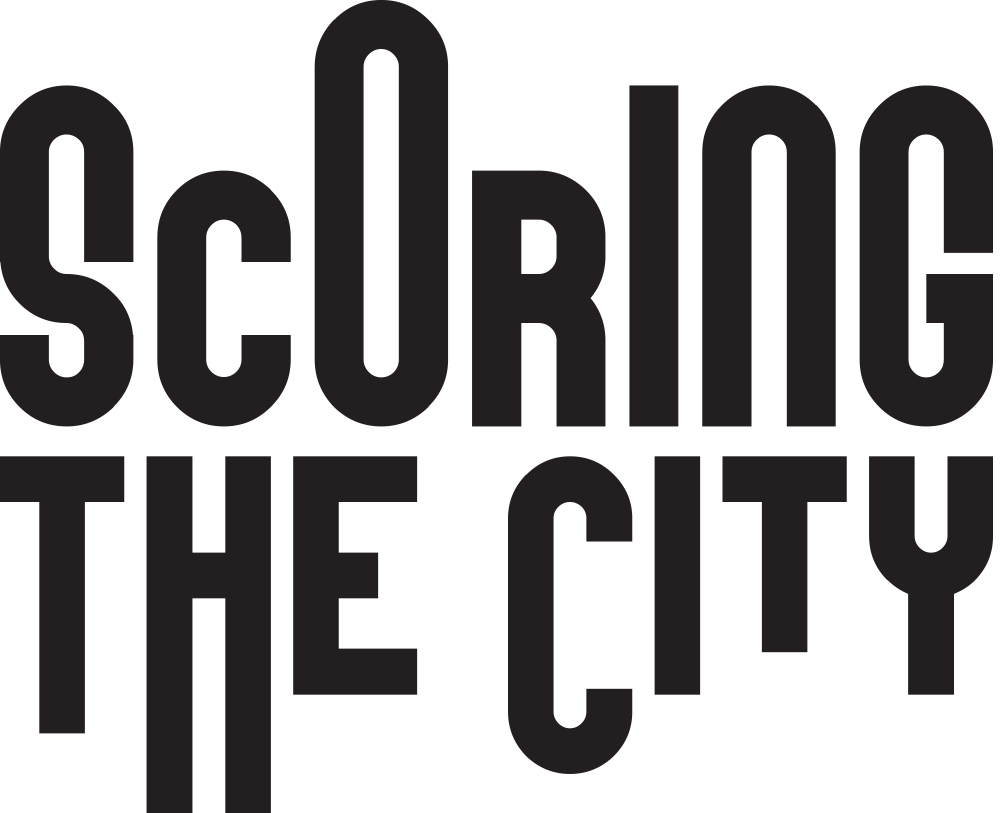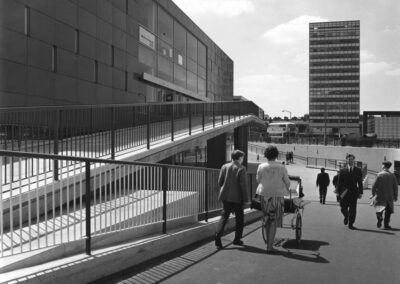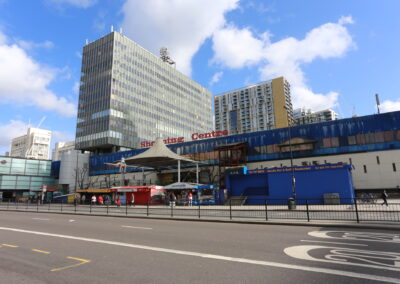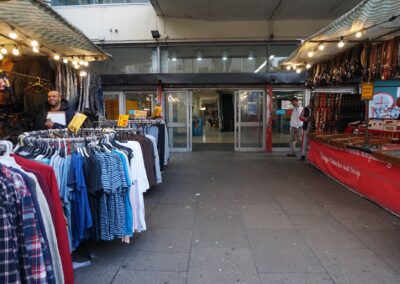As an undergraduate classical music student I was somewhat out of place, being a saxophonist rather than playing a properly ‘classical’ instrument. But I loved playing Bach’s partitas for solo flute, which allowed me to find resonances within the instrument that many contemporary pieces did not. Though seemingly circumscribed, these compositions seemed to me to be more full of possibility than they were of constraint. The notes on the page look dense and strict, but in fact invite so many different articulations or expressions. His compositions take on such different characters by meeting the resonances of different spaces or instruments, but yet Bach is always there in every one of these interpretations. I have heard Bach re-arranged for and performed on instruments like Balinese gamelan and Chinese zither; or as a way for Wendy Carlos to test the limits of new synthesiser technologies in the late 1960s. I have heard his pieces overlaid one on top of another by the Hilliard Ensemble to reveal new layers; or broken into fragments and re-ordered by French opera director Alexandra Lacroix. In every case, scores derived from Bach’s original writings work as a base on top of which to build something new, rather than as a complete representation of the result.
This is not to say that Bach’s music is universal, but rather that it is mobile, in a particular and I believe critical way. Bach’s scores were conceived in a particular set of political conditions, for spaces with particular acoustics, for instruments with certain capacities, under certain economic and cultural exigencies. The kinds of bodily gesture or social gathering that would happen around a Bach score in the early 1800s, most likely in a church or royal court in Leipzig, were shaped by so many material conditions of that place and time – the instruments, the physical norms, the architecture and even the clothing. Now, they are translated via the conditions of our time, and indeed via diverse conditions as Bach’s music has spread with the adoption or imposition of European musical cultures across the globe. In this sense, all scores, but particularly Bach’s with their combination of completeness and openness, are like an infrastructure, that allows things to happen without completely determining their result.
There is a debate in the world of classical music, which is stored primarily in scores but now endlessly recorded, between proponents of historically faithful performance, and those of contemporary re-imagining. Which side I would be on is probably clear, but my interest is elsewhere, in something about the difference between recordings and scores themselves, and how they might help us think about the ways ideas and artefacts within the world of architecture are circulated. Bach’s music was created in a specific space and time, and one way to circulate it now is through recordings that attempt to recreate as faithfully as possible the space-time of its conception, so we can hear it as a perfect artefact unchanged since its composition. Alternatively, we can circulate this music through scores, and learn to recreate them in times and places with different politics, acoustics, technologies and cultures, allowing it to be transformed in the process.
Being realised in performance, the score becomes a meeting point between the situated practice of performers in place, and the mobile media of music written down. Borrowing a phrase from Keller Easterling’s work on the ‘power of infrastructure space‘, a score is knowing to – a guide for making music conceived by a composer, and used by a performer as knowledge, encoded in media, which with to do something that makes sense in their own context. A recording, I would argue, is similar to an urtext (historically accurate) performance in attempting to achieve and then freeze a certain truth. This is what Easterling calls knowing that – in this case knowing that a piece of music must be a certain way, and that the only job of performance is to get there.
The reason I think the score is illuminating, is because it works somewhere between pure universality and pure contextualism – not quite half way on a spectrum between the two (that would be boring) but rather a mix of the best of both. The score starts as pure contextualism – it is an idea, born of an individual, constrained to a greater or lesser degree by the culture they are composing within, perhaps to a commission for certain instrumentalists even. Later, though, it can start to act with a degree of universality – whether by appropriation or violent imposition – circulating globally simply as a suggested set of notes to play, for instrumentalists anywhere to do what they want with. But the score as a medium for communicating a musical idea always carries something of the context it is written in, and is always interpreted with context too. Its universality becomes the possibility of a meeting between contexts, or the translation of one person’s idea through the knowledge of the hands of another (for instrumentalists are manual knowers par excellence, with habitual and idiosyncratic ways of doing rhythm and expression, which are derived from their particular musical training, ingrained in their muscle memories).
I think there is a similar issue in city-making. Forms of architecture and urban design that have been deemed successful, usually in Western Europe and North America, have often been exported to other places as attempted replicas under the auspices of ‘best practice’ and progress. What gets exported, though, is the performance, not the score: a replica of the finished artefact rather than a knowledge base on which to build something new. In this metaphor, I understand the performance and its audience to be analogous with built space and the experience of using it – all the phenomena that arise in the interacting patterns of the space itself, and the practices, rhythms, desires, conflicts of its users. The material and visual culture of a space is one aspect of the performance – not just the architect’s choice of built shapes and finishes but the signs and produce displayed in shop windows, the clothes people wear, the furniture placed outside cafés, the graffiti and flyers for gigs or political causes pasted to walls. If a building is performed differently by its users than its designers had intended, is it a bit like a score?
Modernist architects in the 1960s and 1970s thought they had rationalised urban planning, seeing cities as mechanical systems whose parts could be neatly arranged, with blocks for living, blocks for shopping, roads for cars and pedestrian walkways neatly separated above. Their intentions were good – to make sanitary the slum-like conditions of many inner cities at the time. They aimed to provide housing with light, air, and inside toilets, whilst ‘freeing’ people to use motorcars to move around. In London, the Heygate Estate in Elephant and Castle is a classic example, replacing a network of old terraced streets with high-rise blocks in open green spaces, and a shopping centre raised up and cut off from the street, accessed by car from a large pair of roundabouts. By the 1980s, many considered the ‘modernist experiment’ failed and Conservative politicians abandoned its often state-owned buildings to semi-ruin, along with the communities living in them. Mainstream urban thinking – whether in universities or commercial practices – played into this narrative, branding them ‘bad urbanism’ thanks to their supposed inflexibility and unfriendliness to creative use and informal interactions – and advocated for demolition and redevelopment. This has been the fate of the Heygate Estate. But Elephant’s shopping centre still survives (for now at least), and shows a different model. Its historically-accurate performance as a destination shopping mall accessed by car no longer being relevant, it was re-interpreted by a new set of performers: Latin American immigrants settling particularly in south London. Business-owners from these communities treated its internal layout as a framework, made slight alterations, re-thought the function of its elements, established cafés and beauty salons inside, re-configured shop fronts. Later, market stalls were created on its previously blank street edges, particularly by later West African immigrants. They gave it new life, but also translated it via a new set of material cultures, like Bach revived by being played on contemporary instruments. Perhaps what a Bach score and Elephant and Castle’s shopping centre share in common is that for both of them enough distance has opened up between the space-time of their design and their discovery by new performers, who are less concerned with what they are ‘supposed’ to be than what they make possible now. They appear to us less as an artefact – the work of someone’s hand – than a tool to be manipulated.
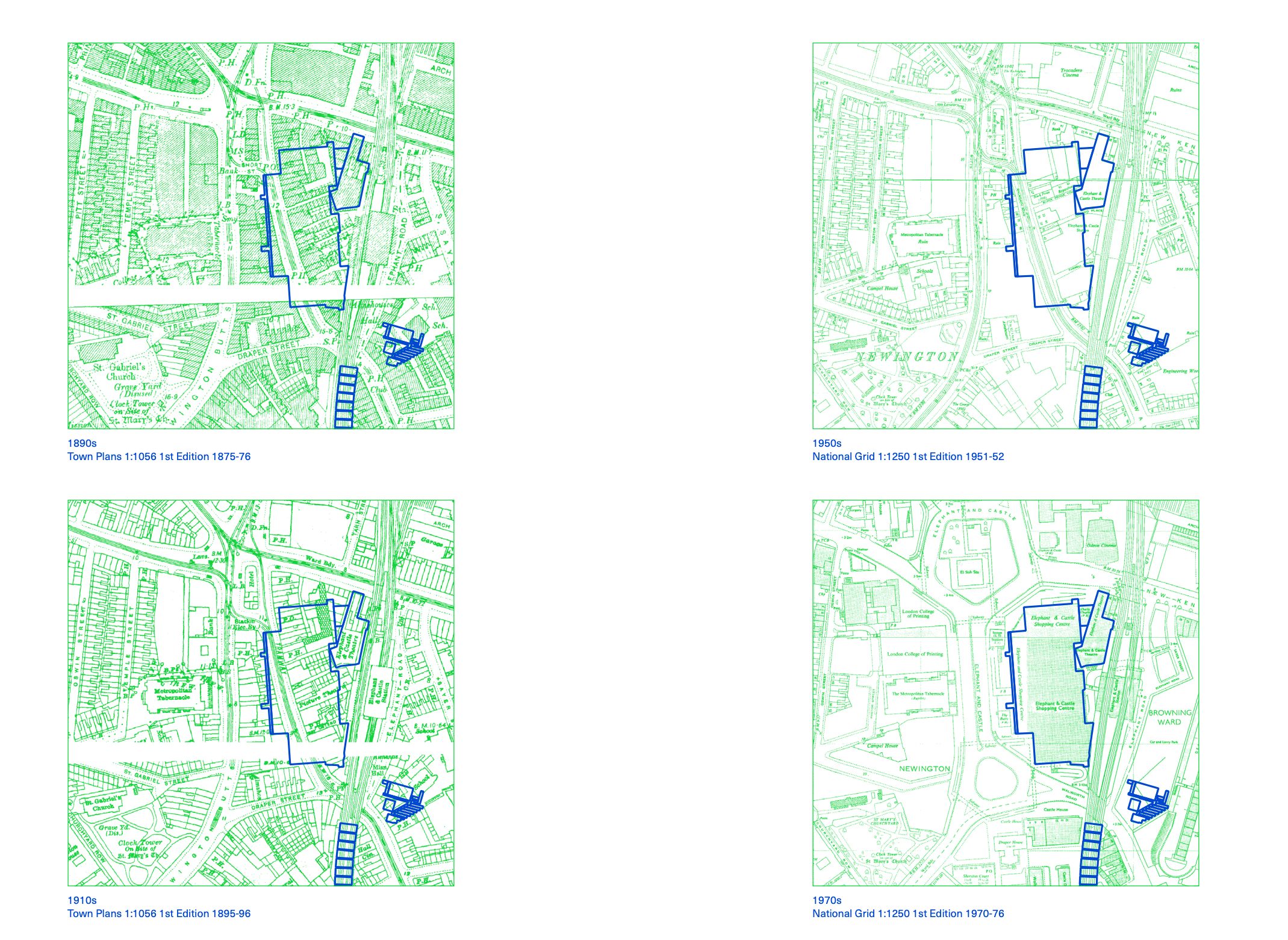
Map of Elephant and Castle showing the outline of the shopping centre over the historical and current urban fabric.
Map by Fani Kostourou. Reproduced from: Kostourou, Fani, Elahe Karimnia, Cecily Chua, Andrea Cetrulo, John Bingham-Hall, and Justinien Tribillon. 2020. ‘Urban Backstages Fieldwork Journal: London’. London: Theatrum Mundi. http://theatrum-mundi.org/library/urbanbackstages-londonfieldwork/.
When a piece of architecture is first realised, though, it acts more like an artefact: it is often treated with a certain reverence. We would not start knocking holes in it, reconfiguring its layout, even though very often the architect has misunderstood the ways the building’s users will perform it. When an architectural or urban design is particularly revered, it gets sent on tour: like a booker at a performing arts centre coveting the orchestra with the most celebrated new recording, property developers or mayors who have seen the architectural photos want the show in their own city. But instead of taking the score and handing it to local performers to interpret, the whole orchestra often gets imported with it. We might imagine the ‘starchitect’ – invited to make his (left in the masculine as this is usually the case in music and architecture alike) mark on the image of the city – as the celebrity conductor programmed to draw in the crowds. And the link might even go beyond analogy – it is often a the commissioning of a new landmark concert hall, like the recent Elbphilharmonie in Hamburg designed by Swiss-French architects Herzog & de Meuron, that a city will turn to in order to cement or claim its place on the world stage of global cultural cities.
So when an architectural ‘performance’ has been popular in one place, we often see that performance ‘re-staged’ elsewhere, and this does not only apply to world-famous concert halls, but things can appear to be more grassroots too. In recent years, we have seen empty buildings or plots in cities across the world become occupied by ‘pop-up’ or temporary cultural and social spaces. What is now a movement started with local activist groups or small socially-focused architecture practices looking for opportunities to create new shared spaces to combat social fragmentation. They developed a recognisable aesthetic: vegetable patches for food growing, furniture made from recycled wood and pallets, handmade bunting and street art. This aesthetic – the final performance of what can be a long socially-driven process of fundraising and fighting for the right to use a site, which builds social fabric in the process – can be replicated by property developers in an instant. Replicating the performance becomes a marketing strategy, to increase interest before a site is developed as flats and appear to be contributing to the community. But by ‘copy-pasting’ the end result, the value of the process, in which communities can find new aims and develop organising capacities to reach them, is lost. The performance is appropriated by the more powerful agent in the situation – the landowner who no longer needs to hand tools over to a community group to make something with themselves, as he or she has already been shown how the performance goes, and can pass off their own version by buying in the right actors and props (bearded baristas and single speed bicycles being typical culprits).
Perhaps it’s a bit like the orchestra on tour, bringing a perfect symphonic rendition to town. What if, instead, the conductor arrived in a place with no performers, no polished and prepared performance, but only the score in hand? They could work with local orchestras to develop their skills and realise the score themselves. The outcome on the stage might be much the same, except to expert ears, or it might be completely different, transformed by its manifestation through local instruments, spaces or ideas of performance. Either way, the backstage processes behind the two performances are radically different in their political and social configurations. One process suggests that if a finished artefact – a performance, or indeed an artwork, is perceived to be ‘good’ by music or art critics in one place, more people should have ‘access’ to that artefact. Those who are seen to make ‘good’ things are asked to recreate it the world over, further consolidating the recognition and economic opportunities they receive for their success. The other process suggests that if something has worked well in one place, there might be knowledge to share from its conception. Could an ‘architectural score’ – one that does not design the end result but offers a guide for actions that bring a final performance into being – act as a media to share this knowledge and enable embedded making processes elsewhere, whose end result might be very different depending on creative remixes or locally-specific material cultures?
Some scores, though, are more open by nature than others. Bach’s solo partitas, which are more like a simple scaffold than a complex interwoven structure, could always be performed on different instruments. Much orchestral music, on the other hand, requires a strict faithfulness to intention in order to regulate the complex relationship between parts. We might think of it more like architectural modernism in its early days, where often the architect’s blueprint could include furniture, fixtures and fittings to make a tightly considered, cohesive whole. During the 20th century, more radically open scores emerged, like some of those referenced in the workshop resources posted on this site. Some of these imagined only a process, like Cornelius Cardew’s The Great Learning, a text offering instructions for a group of people – not necessarily ‘musicians’ – which when followed result in a collective vocal performance that can be different every time. The focus here is on how a group of people listen and respond to one another – often realised by amateurs, the piece benefits from professional facilitation and an emotional and physical investment in interpersonal negotiation. The performance itself can be beautiful but arguably less important than the experience of collectively improvising and interacting. As was the case in a rendition of Paragraph 7 of The Great Learning, facilitated by Gascia Ouzounian in our Beirut workshop, the performers are their own audience, delighting in the the experience of hearing their own voice within the music they co-created. The parallel in architecture might be community planning, in which there is no set outcome but a process of deliberation that can often be long and arduous, but if successful can reinvigorate a community’s sense of pride and togetherness, while engendering a sense of ownership over the new spaces that result.

Left: The opening adagio from JS Bach’s Sonata no.1 in G Minor (BWV 1001) in autograph manuscript, 1720. (Source: Wikipedia)
Right: Paragraph 7 from Cornelius Cardew’s The Great Learning. (Source: https://www.newmusicnewcollege.org/cardew)
Others, like Earl Brown’s December 1952 (included within , appear more like an abstract visual artwork. Brown’s piece itself could certainly be considered a finished artwork, and rather than providing instructions it seems to invite a performer to make a new work, responding to and sitting in parallel with the original, as Steve Davis did in our London and Belfast workshops. Steve talked about his own method for creating music from this visual cue, taking the spaces between markings as a pattern of voids for him to fill. The onus is on the musician’s combination of manual skill and creative imagination to build their own three dimensional sonic structure out of a two dimensional visual cue. If the performer in this case can indeed be considered a builder, their closest reflection in architecture might be the medieval stonemason, a highly regarded craftsperson who carved forms of their own making to complete, for example, a simple cathedral blueprint showing the locations of walls and pillars and the size of voids between them. Their contemporary counterparts – construction workers – have had their labour devalued in comparison to this more level collaboration between conceptor and maker, and architecture collectives like Assemble are attempting to revive the close link between design and construction, foregrounding an ethics of physical investment in the experience of making space together, and a knowledge and care for its materials.
We could continue to explore parallels between the various characters within the making of cities and of music, and their changing, overlapping roles over time: composers and architects, conductors and site managers, builders and performers, audience and users. But why is it worth doing so? To recall, I am thinking of scores as framework for actions whose outcomes might be quite different depending on who enacts them. They are a meeting of knowledge and praxis – where ideas for systems from one place meet bodies that translate those ideas into actions, giving respect to the knowledge embedded in those bodies and in those places. In this sense, I understand scores as infrastructures. In Theatrum Mundi’s work on cultural infrastructure, we are documenting the material, organisational and ecological conditions spaces for cultural production in four cities: London, Paris, Glasgow and Marseille. Our aim is to understand the often invisible, underlying elements that constitute successful models for the provision of opportunities for people to make new forms of creative expression – their infrastructures. Our research will provide a database of these elements that can be reassembled and reinterpreted in new manifestations in other cities trying to increase capacity for and access to cultural production. These infrastructural elements are similar to parts of a score. We are not interested in taking a creative space from one city, imaging it, and replicating its look and feel in another place. Instead we want to show how it is run, how it has been funded and adapted, the social and supply networks that allow it to operate, as a set of ideas to be translated into new forms in other places. So thinking through scores for architecture could be a way to share ideas without imposing outcomes, to give as much agency to the embodied knowledge of making as to the intellectualised processes of design, to have more concern for how things work than how they look, to foreground the social value in collective processes of production as much as the symbolic and economic value of finished artefacts. Ultimately, there is an environmental and a political urgency to this. An obsession with architectural objects and their image has dominated city-making for the last four decades, leading to massive material investment in landmark architectures that devour energy in order to embellish a city’s image whilst doing nothing to empower its residents to produce their own spaces and cultures. The design of these objects – whether imposed by global North starchitects on developing cities, or by wealthy city centre developers on poor, gentrifying neighbourhoods – often suppresses and devalues local embedded knowledge and fails to adapt to local conditions as a result. The replication of these artefacts from one place to another demands the demolition of pre-existing built form and fails to recognise the possibility of new performances for already standing structures. Scores, infrastructures, tools, and re-interpretations – these are the things we should hand on to one another, to share protocols for making rather exporting finished products. What would these scores for spaces look like though? The aim of Scoring the City has been to find out.
